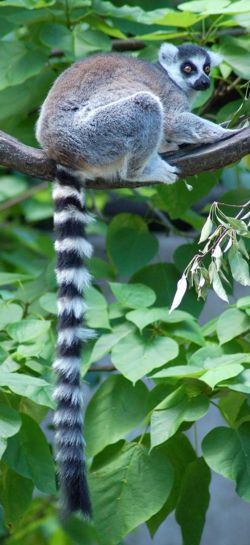Lemur: Difference between revisions
Jump to navigation
Jump to search

imported>Lee R. Berger No edit summary |
imported>Lee R. Berger |
||
| Line 4: | Line 4: | ||
'''Lemurs''' are [[Primate|primates]] that exist only on the island of [[Madagascar]] and the neighbouring islands of the [[Comoros]]. They are among the most primitive of primates. They have moist noses and reflective eyes. They range in body size from the 30 gram Pygmy lemur to the 10kg [[Indri]]<ref name="Fleagle">{{cite book|title=Primate Adaptation and Evolution|accessdate=|author=J. Fleagle|authorlink= |coauthors= |date=1998 |format= |work= |publisher=Academic Press: New York|pages= |language= |archiveurl= |archivedate= |quote= }}</ref><ref name="Szalay">{{cite book |title=Evolutionary History of the Primates|accessdate=|author=F. Szalay and E. Delson|authorlink= |coauthors= |date=2001 |format= |work= |publisher=Academic Press, New York|pages= |language= |archiveurl= |archivedate= |quote= }}</ref>. Due to their geographicaly restricted range and destruction of habitat by humans, all lemur species are considered threatened or [[endangered]]<ref name="Fleagle">{{cite book|title=Primate Adaptation and Evolution|accessdate=|author=J. Fleagle|authorlink= |coauthors= |date=1998 |format= |work= |publisher=Academic Press: New York|pages= |language= |archiveurl= |archivedate= |quote= }}</ref><ref name="Szalay">{{cite book |title=Evolutionary History of the Primates|accessdate=|author=F. Szalay and E. Delson|authorlink= |coauthors= |date=2001 |format= |work= |publisher=Academic Press, New York|pages= |language= |archiveurl= |archivedate= |quote= }}</ref>. | '''Lemurs''' are [[Primate|primates]] that exist only on the island of [[Madagascar]] and the neighbouring islands of the [[Comoros]]. They are among the most primitive of primates. They have moist noses and reflective eyes. They range in body size from the 30 gram Pygmy lemur to the 10kg [[Indri]]<ref name="Fleagle">{{cite book|title=Primate Adaptation and Evolution|accessdate=|author=J. Fleagle|authorlink= |coauthors= |date=1998 |format= |work= |publisher=Academic Press: New York|pages= |language= |archiveurl= |archivedate= |quote= }}</ref><ref name="Szalay">{{cite book |title=Evolutionary History of the Primates|accessdate=|author=F. Szalay and E. Delson|authorlink= |coauthors= |date=2001 |format= |work= |publisher=Academic Press, New York|pages= |language= |archiveurl= |archivedate= |quote= }}</ref>. Due to their geographicaly restricted range and destruction of habitat by humans, all lemur species are considered threatened or [[endangered]]<ref name="Fleagle">{{cite book|title=Primate Adaptation and Evolution|accessdate=|author=J. Fleagle|authorlink= |coauthors= |date=1998 |format= |work= |publisher=Academic Press: New York|pages= |language= |archiveurl= |archivedate= |quote= }}</ref><ref name="Szalay">{{cite book |title=Evolutionary History of the Primates|accessdate=|author=F. Szalay and E. Delson|authorlink= |coauthors= |date=2001 |format= |work= |publisher=Academic Press, New York|pages= |language= |archiveurl= |archivedate= |quote= }}</ref>. | ||
==References== | ==References== | ||
{{reflist}} | {{reflist}} | ||
Revision as of 13:47, 7 September 2007

A Ring-tailed Lemur, (Lemur catta).Template:Photo
Lemurs are primates that exist only on the island of Madagascar and the neighbouring islands of the Comoros. They are among the most primitive of primates. They have moist noses and reflective eyes. They range in body size from the 30 gram Pygmy lemur to the 10kg Indri[1][2]. Due to their geographicaly restricted range and destruction of habitat by humans, all lemur species are considered threatened or endangered[1][2].